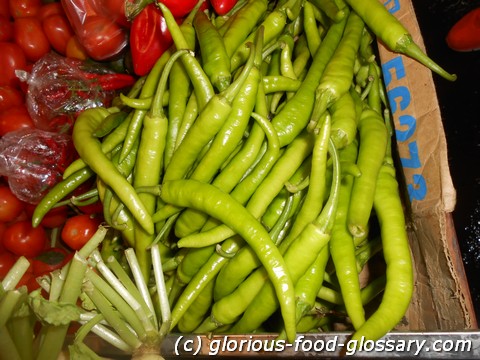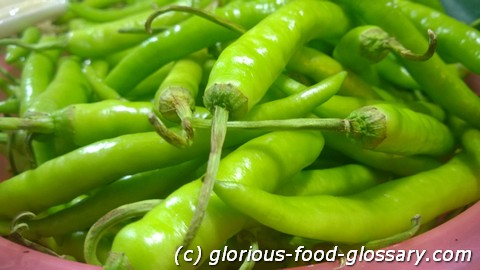Deutsch: Lange Chilischote / Español: Chile Largo / Português: Pimenta Longa / Fraçais: Piment Long / Italiano: Peperoncino Lungo
Siling Haba, commonly known in English as long chili pepper or finger chili, is a type of chili pepper widely used in Filipino cuisine. It is characterized by its long, slender shape and mild to moderate heat level. Siling Haba is an essential ingredient in many Filipino dishes, offering a subtle yet distinct spiciness that enhances the flavor without overwhelming the palate.
Description
Siling Haba is green when unripe and turns red upon maturing, though it is commonly used in both stages of ripeness in cooking. The pepper's heat level can vary but is generally considered milder compared to other varieties like the Thai bird's eye chili. It is used in a variety of dishes, from soups and stews to dips and sauces, contributing both heat and a touch of freshness.
Application Areas
In the culinary context, Siling Haba is versatile and can be found in a range of Filipino recipes. It is a key ingredient in dishes such as "Sinigang," a sour soup known for its tangy tamarind flavor, and "Bicol Express," a creamy, spicy dish made with coconut milk, pork, and chili peppers. Siling Haba is also frequently used as a condiment, either sliced fresh as a garnish or incorporated into spicy vinegar dips known as "sawsawan."
Well-Known Examples
- Sinigang: A sour soup or stew flavored with tamarind and other sour fruits, with Siling Haba adding a mild heat.
- Bicol Express: A spicy Filipino dish made from long chilies, coconut milk, shrimp paste, onion, pork, and garlic.
- Sawsawan: A generic term for Filipino dipping sauces, often enhanced with sliced Siling Haba for added spice.
Treatment and Risks
While Siling Haba peppers are not as hot as some of their chili counterparts, handling them still requires care to avoid irritation to the skin or eyes. It's advisable to wear gloves when slicing or handling large quantities. For those sensitive to spicy foods, incorporating Siling Haba in cooking should be done according to personal heat tolerance levels.
Summary
Siling Haba plays a crucial role in Filipino cuisine, offering a balance of heat and flavor that is integral to many traditional dishes. Its mild spiciness allows it to Complement rather than dominate the flavors of the main ingredients, making it a beloved and indispensable chili pepper variety in the Philippines.
--


Related Articles to the term 'Siling Haba' | |
| 'Kinunot' | ■■■■■■■■■■ |
| Kinunot is a dish from the Philippines, specifically from the Bicol Region which is made with a fish . . . Read More | |
| 'Sambol' | ■■■■■■■■■ |
| Sambol (also spelled sambal) is a term used primarily in South Asian and Southeast Asian cuisines to . . . Read More | |
| 'Saging na Saba (Hilaw)' | ■■■■■■■■■ |
| Saging na Saba (Hilaw) refers to the unripe, green version of the Saba banana, a type of cooking banana . . . Read More | |
| 'Dynamite' | ■■■■■■■■ |
| Dynamite in the food context refers to a popular Filipino Appetizer or snack known for its spicy kick, . . . Read More | |
| 'Gochu' | ■■■■■■■■ |
| Gochu is the Korean word for \'Chili Pepper(s)\'. The Korean red pepper or chili is usually less spicy . . . Read More | |
| 'Pinais na Isda' | ■■■■■■■■ |
| Pinais na Isda is a traditional Filipino dish that involves wrapping fish or shrimp in banana leaves . . . Read More | |
| 'Gochujang' | ■■■■■■■■ |
| Gochujang in the food context refers to a savory, sweet, and spicy fermented condiment widely used in . . . Read More | |
| 'Bird\'s Eye Chili Pepper' | ■■■■■■■■ |
| Bird\'s Eye Chili Pepper refers to a tiny type/variety of peppers which is categorized as hot pepper . . . Read More | |
| 'Halászlé / Halaszle' | ■■■■■■■■ |
| Halászlé / Halaszle: Halászlé refers to Hungarian Fish soup. Halászlé is one of the typical dishes . . . Read More | |
| 'Hongroise' | ■■■■■■■■ |
| Hongroise, in the food context, refers to a culinary style or preparation method that is characteristic . . . Read More | |
